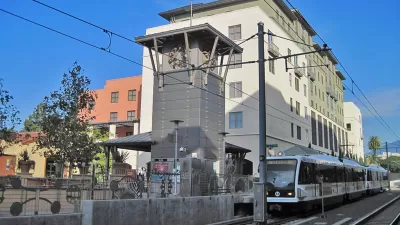It's official, says the EPA: Living in a TOD reduces greenhouse gas emissions more than living in a green, single family home and driving a Prius. The study places major emphasis on local land use decisions in an effort to fight climate change.
In the study, Location Efficiency and Housing Type – Boiling it Down to BTUs (PDF), EPA evaluated the emissions that stem from living in various types of developments and types of vehicles driven and concluded that the key factor was location in reducing one's emissions, rather than the green aspects of one's dwelling and vehicle.
"No factor has a bigger impact than going from conventional suburban to transit-oriented design. Making that change alone results in a 50 percent reduction in energy use in multifamily buildings and 42 percent and 39 percent reductions in single family attached and detached dwellings. In fact, the most inefficient TOD beats the most efficient Conventional suburban development (CSD) in this study."
From Streetsblog DC: "The report serves as a high-level rebuke to those who dismiss the importance of smart growth for curbing energy use, a point of view that was reinforced by a recent report from the Pew Center on Global Climate Change."
From Grist: Wanna green your ride? Ditch the Prius, hop on a train: "A new EPA study says that moving from a car-oriented to a transit-oriented community has the biggest impact on your energy usage -- more than green buildings or green cars."
Thanks to California League of Conservation Voters
FULL STORY: Study: Transit outperforms green buildin

Pennsylvania Mall Conversion Bill Passes House
If passed, the bill would promote the adaptive reuse of defunct commercial buildings.

Planning for Accessibility: Proximity is More Important than Mobility
Accessibility-based planning minimizes the distance that people must travel to reach desired services and activities. Measured this way, increased density can provide more total benefits than increased speeds.

World's Largest Wildlife Overpass In the Works in Los Angeles County
Caltrans will soon close half of the 101 Freeway in order to continue construction of the Wallis Annenberg Wildlife Crossing near Agoura Hills in Los Angeles County.

Amtrak Takes Lead on Texas Central Rail
The high-speed rail project isn’t a done deal, but if it moves forward, trains could begin operating in 2030.

Maine Approves Rent Relief Program
Legislators hope the assistance program will help struggling low-income households avoid eviction.

How Transit Architecture Impacts Real and Perceived Safety
More than a third of Americans believe major transit systems are too unsafe to ride. The built environment can change that.
City of Costa Mesa
Licking County
Barrett Planning Group LLC
HUD's Office of Policy Development and Research
Mpact Transit + Community
HUD's Office of Policy Development and Research
Tufts University, Department of Urban and Environmental Policy & Planning
City of Universal City TX
ULI Northwest Arkansas
Urban Design for Planners 1: Software Tools
This six-course series explores essential urban design concepts using open source software and equips planners with the tools they need to participate fully in the urban design process.
Planning for Universal Design
Learn the tools for implementing Universal Design in planning regulations.

























